Joe Blevins's Blog, page 17
September 14, 2024
Ed Wood's Warm Angora Wishes: "Octodeathopus: The Legend of Lobo"
 How did Lobo become Lobo? Strap in, pally, and you'll find out.
How did Lobo become Lobo? Strap in, pally, and you'll find out.The story: "Octodeathopus: The Legend of Lobo" by J. "Doc Dread" Murray
NOTE: This article continues my coverage of Ed Wood's Warm Angora Wishes and Rubber Octopus Dreams (Arcane Shadows Press, 2024).
Synopsis: In 1904, presumably somewhere in Eastern Europe, twin brothers Otto and Joseph Javorsky (aged four) are wrestling in front of their family's cottage when Otto is suddenly scooped up by a caravan of passing gypsies. Otto becomes part of the gypsies' traveling show and eventually takes the place of a wrestling bear named Lobo when that animal passes away. He even assumes Lobo's name as his own. By 1927, however, they decide to trade Lobo to a group of Tibetans in exchange for supplies. The Tibetans use Lobo as a beast of burden.
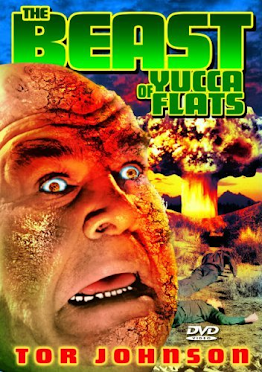 Lobo's brother. See the resemblance?In 1945, the now-grown Joseph Javorsky works on the top-secret Atomic Super Man project with fellow scientists Dr. Eric Vornoff and Professor Strowski. But the project is suddenly canceled by the government in 1946, and Vornoff is forced to flea. His goal is to make it to the United States to continue his work, but he first heads to Tibet. There, he is amazed to find a man he initially thinks is Joseph Javorsky but is actually Joseph's twin brother, Otto aka Lobo. Vornoff soon makes Lobo his obedient servant. They travel together and pick up an octopus at a market in Shanghai.
Lobo's brother. See the resemblance?In 1945, the now-grown Joseph Javorsky works on the top-secret Atomic Super Man project with fellow scientists Dr. Eric Vornoff and Professor Strowski. But the project is suddenly canceled by the government in 1946, and Vornoff is forced to flea. His goal is to make it to the United States to continue his work, but he first heads to Tibet. There, he is amazed to find a man he initially thinks is Joseph Javorsky but is actually Joseph's twin brother, Otto aka Lobo. Vornoff soon makes Lobo his obedient servant. They travel together and pick up an octopus at a market in Shanghai. In 1947, with the octopus in tow and growing larger all the time, Vornoff and Lobo head for America aboard a rusted-out freighter. Along the way, they kill the ship's captain and loot the strongbox. By October 1948, they have settled in Lake Marsh, California, and Vornoff resumes his work. Lobo and Vornoff haven't been living in the area long when they fatally run over an old widower in their car. The incident is investigated by a local cop, Officer Kelton. Vornoff is somewhat distressed by this, but he is excited that he's found a house, the Old Willows Place, that is perfect for his experiments. It even has a perfect pond for his octopus.
Flash forward to 1955. Local newspaper reporter Janet Lawton tells of her horrific experiences at the Old Willows Place, where Dr. Vornoff tried to use her and her fiancé, policeman Dick Craig, in his dreadful medical experiments. Luckily, they managed to escape when the place went up in flames and Vornoff was killed by his own octopus. But the story is not over! Both Lobo and the octopus manage to survive. And Joseph Javorsky, still very much alive, arrives by plane in America at a place called Yucca Flats to begin a new project.
Excerpt:
The octopus has grown since we've boarded this old, rusted freighter. It seems there is an endless supply of rats aboard this vessel. The octopus leaves its tank and hunts our quarters at night. The captain is a drunk and has found a shipping container of fine vodka. In a drunken stupor he told me where the ship's strong box is and the treasures it contains. No one will be surprised should he fall overboard.Reflections: "Octodeathopus" is yet another story in Warm Angora Wishes that draws heavily upon Ed Wood's Bride of the Monster (1955) and Plan 9 from Outer Space (1957) and attempts to weave these films into a larger narrative, along with several other sci-fi and horror films of the era. For me, the real stroke of genius here is the revelation that Lobo, Tor Johnson's character from Bride, is the twin brother of Dr. Joseph Javorsky, the doomed Soviet scientist that Tor played in Coleman Francis' The Beast of Yucca Flats (1961). Apparently, Lobo's real name was Otto, and he and Joseph grew up together until Otto was plucked up by some passing gypsies at the age of four. Come to think of it, those guys do look a lot alike.
I was also highly amused to learn that it was Lobo who actually ran over Bela Lugosi's unfortunate Ghoul Man character from Plan 9. It seems that Dr. Eric Vornoff unwisely allowed his hulking manservant to drive that day. Whoops! Later in the story, author J. "Doc Dread" Murray includes a clever reference to It Came from Beneath the Sea (1955). The giant octopus from that film, we learn, is actually Vornoff's beloved pet. It lost a couple of tentacles in the explosion at the end of Bride, which is why it only has six arms in Beneath the Sea. The timing on this could not have been better, since MeTV's Svengoolie just showed It Came from Beneath the Sea a few weeks ago, meaning that film was still fairly fresh in my mind.
With a title like "Octodeathopus," you can tell that this story is not taking itself seriously at all. It's just a fun little bit of speculative fan fiction that will probably be incomprehensible to anyone outside the Ed Wood fan community. But if you're an active part of that community and have seen Eddie's 1950s films dozens of times, to the point where the characters have taken up permanent residence in your brain, J. "Doc Dread" Murray's strange tale should be quite a pleasant little diversion.
var infolinks_pid = 3415273; var infolinks_wsid = 0;
Published on September 14, 2024 13:16
September 11, 2024
Ed Wood's Warm Angora Wishes: "Children of the Sun"
 This story emphasizes the vampiric nature of Vampira.
This story emphasizes the vampiric nature of Vampira.The story: "Children of the Sun" by Joe Overbay
NOTE: This article continues my coverage of Ed Wood's Warm Angora Wishes and Rubber Octopus Dreams (Arcane Shadows Press, 2024).
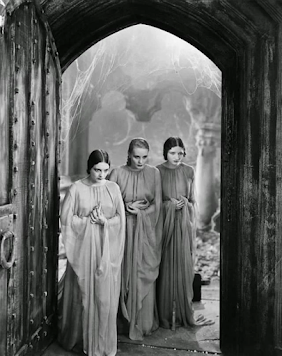 Dracula's brides from the 1931 film.Synopsis: Vanessa Davis, an ex-NASA test pilot turned secret agent, is piloting a propeller plane to Romania as part of her latest dangerous mission. Her passenger is a mysterious, powerful man she has only recently met named Anton Voytek. For this mission, they are both using codenames. His is Lucifer; hers is Vampira. Over the Transylvanian Alps, the plane runs into bad weather and has to land. When Vanessa looks at Anton in the mirror, she realizes to her horror that he casts no reflection. Once the plane is on the ground, Vanessa tries to outrun Anton but to no avail. He soon overpowers her.
Dracula's brides from the 1931 film.Synopsis: Vanessa Davis, an ex-NASA test pilot turned secret agent, is piloting a propeller plane to Romania as part of her latest dangerous mission. Her passenger is a mysterious, powerful man she has only recently met named Anton Voytek. For this mission, they are both using codenames. His is Lucifer; hers is Vampira. Over the Transylvanian Alps, the plane runs into bad weather and has to land. When Vanessa looks at Anton in the mirror, she realizes to her horror that he casts no reflection. Once the plane is on the ground, Vanessa tries to outrun Anton but to no avail. He soon overpowers her.Some time later, Vanessa wakes up in a coffin in a remote chateau. She opens a curtain, only to be burned by sunlight. She is greeted by Diana, another female vampire under Anton's control. Vanessa soon realizes what she has become. Her life now revolves around hunting human beings and drinking their blood. Whenever she can, she lashes out at Anton and the other vampires in his "brood," but she is generally unsuccessful because she herself has the same weaknesses they do. She does manage to impale Diana, but Anton proves impossible to kill.
Eventually, with numerous vampires following her, Vanessa makes it back to her plane and even manages to take off. Anton takes the form of a bat and pursues her. They have an epic battle in the air, ending when Vanessa crashes the plane. Unfortunately, when the smoke clears, it is Anton who survives. He declares Vanessa to be a worthy adversary and sends her mortal remains back to her hometown of Oakdale, CA. Back home, Vanessa's elderly husband attends her funeral but is so grief-stricken that he himself wanders into traffic and is killed. Soon after, aliens begin to invade the earth as part of an initiative called Plan 9.
Excerpt:
She tried to fight him, but she just couldn't. To this moment her life mind and soul were hers alone to command, and the agency had invested long years training her to keep her that way she's been judged resistant to almost all forms of external persuasion. But this was different. Anton, this vampire, was inside her mind, and there was no damn way she could keep him out. In a moment, he knew her innermost thoughts, of her dreams, all the private things that she cherished. In a moment she was mind raped and in the end she was his.Reflections: As I've made my way through Warm Angora Wishes, I've occasionally found myself wondering what would happen if someone totally unfamiliar with Ed Wood's films picked up this book and started leafing through it. How would that happen? Maybe, years from now, a copy turns up at a used bookshop, and the cover catches a shopper's attention. Would such a reader be able to make any sense of it? Or does the reader have to have at least a passing knowledge of Ed's 1950s films, particularly Bride of the Monster (1955) and Plan 9 from Outer Space (1957) to be able to enjoy this anthology?
Take "Children of the Sun" as an example. Now, on the surface, there is plenty here to entertain the average reader of genre fiction, regardless of that person's level of familiarity with Ed Wood. At heart, this is a horror story that emphasizes the punishing physical and mental tortures of being a vampire. Vampirism is often romanticized in film and literature, so it was strangely refreshing to read Joe Overbay's brutal, unappetizing take on the lifestyle—which is basically like being a junkie, but a thousand times worse. And all of this is set against a backdrop of Cold War intrigue, complete with plenty of tense, high-flying action sequences. The author is mashing up a couple of popular genres in this story, so there's something for everybody... theoretically.
But what is the uninitiated reader to make of the early, totally-out-of-nowhere reference to UFOs? Or the mention of someone called Dr. Eric Vornoff? Or the fact that, in the final paragraphs of this story, the setting suddenly switches from Transylvania to California and involves aliens invading the earth? My guess is that these aspects of the story would be very, very confusing to an outsider. That's not a problem, necessarily. It's just something that's been on my mind. Maybe that's the secret gift of Ed Wood; as a muse, he lets you make imaginative leaps you might not otherwise dare.
var infolinks_pid = 3415273; var infolinks_wsid = 0;
Published on September 11, 2024 03:00
September 6, 2024
Ed Wood's Warm Angora Wishes: "Spyang Ki Chung 'Little Wolf'"
 This story shows us what Lobo was like before he hit the big time.
This story shows us what Lobo was like before he hit the big time.The story: "Spyang Ki Chung 'Little Wolf'" by Adkov Telmig
NOTE: This article continues my coverage of Ed Wood's Warm Angora Wishes and Rubber Octopus Dreams (Arcane Shadows Press, 2024).
 A monastery in Western Tibet.Synopsis: Exiled Russian scientist Dr. Eric Vornoff scavenges in the desolate Western Plateau of Tibet. He is fully aware that agents from his home country are after him, and he nearly succumbs from the harsh weather and the heavy equipment he is lugging around. Luckily, he is rescued by a caravan of nomads and taken to a small mining town. In a largely deserted monastery, Vornoff meets and (after a fashion) befriends a three-foot-tall monk known as Little Wolf. Vornoff and Little Wolf visit a local market to buy food. There, Vornoff sees a man with some of the valuable uranium he desperately needs for his experiments. The man agrees to bring Vornoff plenty of uranium in exchange for a large sum of money.
A monastery in Western Tibet.Synopsis: Exiled Russian scientist Dr. Eric Vornoff scavenges in the desolate Western Plateau of Tibet. He is fully aware that agents from his home country are after him, and he nearly succumbs from the harsh weather and the heavy equipment he is lugging around. Luckily, he is rescued by a caravan of nomads and taken to a small mining town. In a largely deserted monastery, Vornoff meets and (after a fashion) befriends a three-foot-tall monk known as Little Wolf. Vornoff and Little Wolf visit a local market to buy food. There, Vornoff sees a man with some of the valuable uranium he desperately needs for his experiments. The man agrees to bring Vornoff plenty of uranium in exchange for a large sum of money.With Little Wolf's help, Vornoff is granted permission from an aged monk to set up his equipment and perform his experiments within the monastery. He says he will use atomic power to create a race of supermen. When the man from the marketplace shows up with the promised uranium, Vornoff casually shoots and kills him. When Little Wolf asks him why he did this, Vornoff replies that he has no money but needed the uranium to continue his work. What else was he supposed to do? Little Wolf then asks to be part of Vornoff's experiment. Vornoff tells his companion that it will be painful but that he will emerge from the experience more powerful than he has ever been.
Two enemy agents, identified only as the Cold Men, show up at the monastery in their relentless hunt for the exiled scientist. Vornoff does not seem terribly concerned by their arrival because he now has a powerful bodyguard: Little Wolf, now supersized and mute. The formerly-diminutive monk makes quick work of the Cold Men, literally tearing their bodies apart. Vornoff decides that Little Wolf's name no longer suits him. From now on, he shall be called Lobo.
Excerpt:
A small detachment of Tibetan soldiers kept wary watch on the scrofulous lot. They stood in tight groups, warming their hands over fires in metal barrels. They stood out in their uniforms and furred hats. All of them seemed to smoke thin stick-like, oily-looking black cigarettes. They eyed Vornoff suspiciously, but none of them had questioned him or asked him for papers. It wasn’t the kind of town where questions were common. This was a good thing for Dr. Vornoff who had by now crossed four or five borders without the benefit of any official passports or permits.
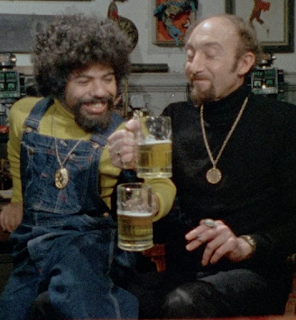 Sardu and Ralphus: best friends.Reflections: When I first downloaded my copy of Warm Angora Wishes from Amazon, I skimmed through it a little, just to get the lay of the land. I casually noticed that one story was about how Dr. Eric Vornoff (Bela Lugosi) and his mute henchman Lobo (Tor Johnson) from Bride of the Monster (1955) originally met in "the wilderness of Tibet." Someone had taken that throwaway line from the movie and made a whole prequel out of it. But I didn't want to spoil the story for myself, so I merely glanced at a few sentences and moved on. I suppose I was anticipating something like the story of how the Lone Ranger met Tonto. My curiosity level was at roughly six out of ten; prequels have a tendency to overexplain things that were better left unknown.
Sardu and Ralphus: best friends.Reflections: When I first downloaded my copy of Warm Angora Wishes from Amazon, I skimmed through it a little, just to get the lay of the land. I casually noticed that one story was about how Dr. Eric Vornoff (Bela Lugosi) and his mute henchman Lobo (Tor Johnson) from Bride of the Monster (1955) originally met in "the wilderness of Tibet." Someone had taken that throwaway line from the movie and made a whole prequel out of it. But I didn't want to spoil the story for myself, so I merely glanced at a few sentences and moved on. I suppose I was anticipating something like the story of how the Lone Ranger met Tonto. My curiosity level was at roughly six out of ten; prequels have a tendency to overexplain things that were better left unknown.I could not have predicted anything like "Spyang Ki Chung," which is easily one of the strangest and most intriguing stories I've read so far in this collection. Obviously, the story has an outrageous central gimmick, i.e. that the huge, lumbering Lobo was once a dwarf in a monastery and that it was Vornoff who made him a giant. It's exactly the kind of imaginative leap you'd hope to find in an Ed Wood-inspired anthology. But what really makes the story memorable are its descriptive passages about Tibet. This is a land about which I know virtually nothing, so I was fascinated by the author's evocative yet unsentimental prose about the land and its people. "Spyang Ki Chung" is the first story in this collection to remind me of Cormac McCarthy. I wager it'll be the last, too.
This story also got me thinking about villains with dwarf sidekicks. That seems to be a semi-common trope in fiction, but I'm hard-pressed to think of good examples. Let's see. There's Sardu and Ralphus in Bloodsucking Freaks (1976), Dr. Evil and Mini-Me in The Spy Who Shagged Me (1999), and Livia and the Imp in The Undead (1957). Didn't Hordak also have an imp on She-Ra (1985-1987)? Mr. Roarke on Fantasy Island (1977-1984) was more mysterious than evil, so he doesn't count. Do Jabba the Hutt and Salacious Crumb from Return of the Jedi (1983) count? Maybe Salacious isn't a dwarf among his own kind, but he's dwarfed by Jabba.
Come to think of it, this might not be that common a trope.
var infolinks_pid = 3415273; var infolinks_wsid = 0;
Published on September 06, 2024 16:40
September 4, 2024
Ed Wood's Warm Angora Wishes: "The Return of Martin Crandle"
 Finally, your favorite Ed Wood character has returned!
Finally, your favorite Ed Wood character has returned!The story: "The Return of Martin Crandle" by Everett Dudgeon
NOTE: This article continues my coverage of Ed Wood's Warm Angora Wishes and Rubber Octopus Dreams (Arcane Shadows Press, 2024).
Synopsis: Juvenile delinquent Paula Parkins and her young partners in crime, Phyllis and Geraldine, are on the run from the law and looking for a place to hide as a nasty storm approaches. They've been committing robberies and murders and have lost some members of their gang in the process. They now approach a foreboding swamp called Lake Marsh. Phyllis expresses concerns about going anywhere near "that place," but Paula willfully ignores her.
Meanwhile, at police headquarters, Captain Robbins and Sgt. Martin Crandle discuss the recent crime wave. Martin is shocked to hear that Robbins suspects local girl Paula Parkins is to blame, since Martin knows that Paula comes from a respectable family. Martin is also disturbed to hear that Paula and her girls are headed to Lake Marsh. That location holds some painful memories: Martin's ex-partner, Dick, and Dick's fiancée, Janet, were so traumatized at Lake Marsh that they may as well be dead. Martin reluctantly agrees to go to Lake Marsh to save Paula and the girls from a similar fate.
Back at the swamp, Paula decides to park her car before it gets hopelessly stuck in the mud. She and the girls will continue on foot, and Paula doesn't want to hear any nonsense about "monsters." They trudge through the swamp, hoping to make it to a cemetery on the other side. Paula is more scared than she lets on. Finally, she and the girls are stunned to see the Old Willows Place, a house that was supposedly destroyed several years ago.
Martin travels to Lake Marsh, driven by Sgt. Dan Bradford, with whom he does not get along particularly well. They almost hit someone or something but narrowly avoid an accident. Not far away, Paula and the girls explore the outside of the house and are shocked when the front door opens by itself. Geraldine and Phyllis are reluctant to enter, but Paula insists that the house will at least offer them shelter. Martin and Bradford bumble their way through the swamp and finally find the Old Willows Place. Phyllis is trembling outside, her hair white with fear. Despite Bradford's warning, Martin enters the house himself.
Excerpt:
Marty pulled the chesterfield from his mouth and held his face in his hands as Robbins continued about how Marty wouldn’t be alone and how someone else was going to be at the cemetery nearby in case the girls wanted to sneak in there. Marty wasn’t really listening though-everything was muffled. All he could think of was if he was going to end up like Dick.Reflections: To be honest, I had never paid much attention to Martin, a plainclothesman played earnestly by Don Nagel in Bride of the Monster (1955). Keep in mind, I once wrote a whole article about the sassy file clerk from that same film, but somehow I'd never given Nagel's character a second thought. I mean, what does this guy even do in the movie? Well, he shows up about half an hour into it to serve as a sidekick to the hero, Lt. Dick Craig (Tony McCoy). I suspect Martin exists mainly to give Dick someone to talk to during the middle passages of the movie, sort of like how Disney princesses are often given animal sidekicks to act as sounding boards. But Martin sticks around for the rest of the movie, even after he's separated from Dick Craig, and is present if not prominent during the story's chaotic, action-packed conclusion.
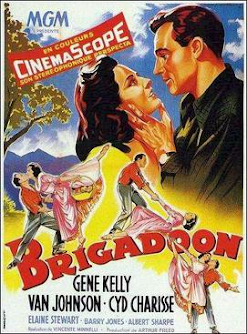 A Brigadoon from hell.Honestly, Martin gets a decent chunk of screen time in Bride of the Monster, more than I'd remembered. He smokes, drinks coffee, grumbles about his dislike of the swamp, stands around, and banters good-naturedly if wearily with his partner. Later, when Dick is taken prisoner by the deranged Dr. Eric Vornoff (Bela Lugosi), Martin joins forces with some other cops, including Capt. Robbins (Harvey B. Dunn) and Officer Kelton (Paul Marco), to search the Old Willows Place and the surrounding area. Don Nagel plays a similar cop character in Night of the Ghouls (1959), the direct sequel to Bride, though he's referred to as Crandle in that film. It's reasonable to assume that Martin and Crandle are the same guy: a competent if unremarkable police officer who helps round out the cast.
A Brigadoon from hell.Honestly, Martin gets a decent chunk of screen time in Bride of the Monster, more than I'd remembered. He smokes, drinks coffee, grumbles about his dislike of the swamp, stands around, and banters good-naturedly if wearily with his partner. Later, when Dick is taken prisoner by the deranged Dr. Eric Vornoff (Bela Lugosi), Martin joins forces with some other cops, including Capt. Robbins (Harvey B. Dunn) and Officer Kelton (Paul Marco), to search the Old Willows Place and the surrounding area. Don Nagel plays a similar cop character in Night of the Ghouls (1959), the direct sequel to Bride, though he's referred to as Crandle in that film. It's reasonable to assume that Martin and Crandle are the same guy: a competent if unremarkable police officer who helps round out the cast.And now, thanks to author Everett Dudgeon, we have Martin as the central character in his own story. Or half of his own story, anyway. He shares the stage with Paula and the gals from The Violent Years (1956), and the author makes references to numerous other films along the way. Paula, for instance, is a big fan of gangster Vic Brady from Jail Bait (1954), and she and her gals contemplate the pros and cons of working for smut peddler Johnny Ride from The Sinister Urge (1960). In many ways, this story feels like a companion piece to "The Violent Urge" by Brian Carney, which tied some of Ed Wood's crime thrillers together into a "Delinquiverse."
What sets "The Return of Martin Crandle" apart from Carney's story is its supernatural Gothic elements, specifically the use of the Old Willows Place, the weather-beaten mansion where Dr. Eric Vornoff carried out his unspeakable experiments before an atomic explosion brought it all to an end. The large, decaying house magically reappears out of the ether in this story, much like the quaint Scottish village did in Brigadoon (1954). But it took that village a century to reconstitute itself, and the Willows Place manages the same feat in just a few years. So it's more like Microwave Brigadoon or Brigadoon-2-Go.
In all seriousness, Everett Dudgeon is to be congratulated for creating some genuinely spooky atmosphere in this story. The Old Willows Place is a central location in two of Ed Wood's movies, and it's a source of great fascination for all Wood fans. But it's rarely been as imposing or as threatening as it is in this story. Here, it seems like a portal into hell itself.
var infolinks_pid = 3415273; var infolinks_wsid = 0;
Published on September 04, 2024 03:00
September 3, 2024
Podcast Tuesday: "Throw Out Your Hands, Stick Out Your Tush"
 The Three Musketeers confront Fonzie on The Fonz and the Happy Days Gang.
The Three Musketeers confront Fonzie on The Fonz and the Happy Days Gang.In 1981, ABC gave The Fonz and the Happy Days Gang a second season, bringing the series' overall episode total to 24. That may not sound terribly impressive, but it's pretty good for a Saturday morning series of this vintage. Let me put this in perspective. Scooby-Doo, Where Are You? (1969-1970)—a beloved series that launched a lucrative multimedia empire, let's not forget—ran for only 25 episodes. Other classic HB series, like Jabberjaw (1976) and Hong Kong Phooey (1974), only got one season apiece.
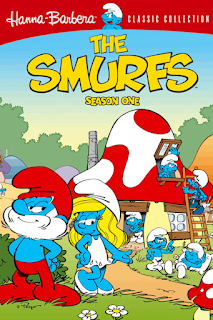 A game-changer at NBC.And this phenomenon wasn't limited to just Hanna-Barbera. Sid and Marty Krofft's signature series, H.R. Pufnstuf, ran just 17 episodes. In those days, networks tended to order just a handful of episodes of children's shows, then rerun those episodes over and over for years. I say all of this because I want people to stop saying The Fonz and the Happy Days Gang was a failure because it didn't run 100 episodes. It did remarkably well, in fact.
A game-changer at NBC.And this phenomenon wasn't limited to just Hanna-Barbera. Sid and Marty Krofft's signature series, H.R. Pufnstuf, ran just 17 episodes. In those days, networks tended to order just a handful of episodes of children's shows, then rerun those episodes over and over for years. I say all of this because I want people to stop saying The Fonz and the Happy Days Gang was a failure because it didn't run 100 episodes. It did remarkably well, in fact.However, on September 12, 1981 (my sixth birthday, incidentally), NBC debuted a Saturday morning series that would definitely buck the trend: The Smurfs (1981-1989). Peyo's iconic little blue creatures had been extremely popular in Europe for years, even getting their own movie and topping the UK pop charts, but they didn't hit in America until they got their own Hanna-Barbera series in the '80s. They quickly made up for lost time, however, and The Smurfs became a naitionwide pop culture sensation. And NBC didn't just make a small handful of episodes this time. They let the show run for nine seasons and 256 episodes. That's one more episode than the live-action Happy Days (1974-1984).
As it happens, the first episode of The Smurfs aired opposite the second season premiere of The Fonz and the Happy Days Gang. The latter is a Three Musketeers parody called "The French Correction." And that's exactly the episode we're reviewing on this week's installment of These Days Are Ours: A Happy Days Podcast . Check it out below!
var infolinks_pid = 3415273; var infolinks_wsid = 0;
Published on September 03, 2024 14:16
September 2, 2024
Ed Wood's Warm Angora Wishes: "Best Laid Plans"
 A tattooed rooster is just part of "Best Laid Plans."
A tattooed rooster is just part of "Best Laid Plans."The story: "Best Laid Plans" by R.S. Butler
NOTE: This article continues my coverage of Ed Wood's Warm Angora Wishes and Rubber Octopus Dreams (Arcane Shadows Press, 2024).
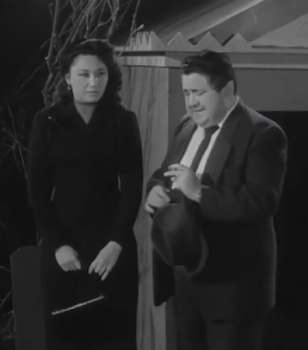 The mourners of Plan 9.Synopsis: Aboard Space Station 7, orbiting somewhere in the cosmos, the alien ruler Reagor laments the failure of Plan 9. Some members of his race had visited Earth and had used electrodes to bring several dead earthlings back to life: an old man named Mora, his wife Luna, and a police officer named Inspector Clay. The goal had been to frighten the earthlings into submission and thus prevent them from developing a deadly weapon called Solaronite. But the plan, led by aliens Eros and Tanna, had been a disaster. Both Eros and Tanna had been killed, their ship had exploded, and the three zombies they'd managed to create had all been destroyed.
The mourners of Plan 9.Synopsis: Aboard Space Station 7, orbiting somewhere in the cosmos, the alien ruler Reagor laments the failure of Plan 9. Some members of his race had visited Earth and had used electrodes to bring several dead earthlings back to life: an old man named Mora, his wife Luna, and a police officer named Inspector Clay. The goal had been to frighten the earthlings into submission and thus prevent them from developing a deadly weapon called Solaronite. But the plan, led by aliens Eros and Tanna, had been a disaster. Both Eros and Tanna had been killed, their ship had exploded, and the three zombies they'd managed to create had all been destroyed.Reagor's chief scientist, Daco, demonstrates how he has already cloned the zombie police officer, Inspector Clay. Reagor is pleased by this and imagines a whole army of Clay zombies with which he could easily conquer Earth. The alien ruler then meets with Alros, who is taking over the mission that his late brother Eros started. Alros reports that he will now use Plan 13, which involves turning humans into animals, and states that he will initiate this plan in San Fernando, CA, the same town that had been the focal point of Plan 9.
Meanwhile, in San Fernando, a human couple named Alvin and Sylvia Houser are awaiting the arrival of Sylvia's freeloading Uncle Stanley. Al and Sylvia are the same couple who attended Mora's funeral and discovered the bodies of the gravediggers at the local cemetery. (From the Housers' conversation, we learn that Mora and Luna were actors, which is why they were buried in vampire costumes.) There is a flash of bright light outside the house, and they discover a rooster with a Marine tattoo in Uncle Stanley's car. Stanley himself, however, seems to be missing.
The next morning, the Housers are stunned to see numerous strange animals wandering the streets of their neighborhood. Some of these creatures are wearing familiar items of clothing, leading the Housers to believe that human beings are being turned into animals. A strange beeping sound compels them to visit the nearby cemetery, where they discover a flying saucer. By remote control, Alros zaps Alvin with various painful rays but fails to turn him into an animal. The aliens declare Plan 13 a failure and depart, leaving the Housers to tell their strange story to the police officers who have arrived on the scene.
Back at Space Station 7, Alros reports to Reagor that Plan 13 has also failed. He says the aliens should now follow Plan Zero, which involves doing nothing whatsoever. Through their pollution and unhealthy habits, the earthlings will destroy themselves long before they get around to inventing Solaronite. Reagor is very pleased to hear this.
Excerpt:
"Very well, Your Excellency," responded Alros. "We at first tried Plan 11 where we turned off their power and then intermittently turned on a light at one house or a light at another and so on. They each thought each other was the cause of the goings on and soon each one was bitted against each other. As an experiment we targeted one of their streets, Maple Street, I believe. The results were very favorable."
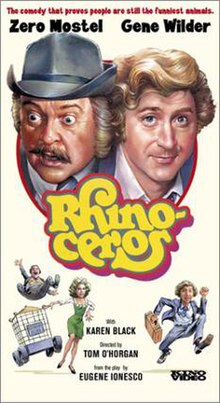 Rhinoceros (1974)Reflections: After a brief and welcome detour into Ed Wood's crime thrillers, Warm Angora Wishes returns to familiar territory with "Best Laid Plans." This is yet another story set in the universe of Plan 9 from Outer Space (1957), and, like most of the others, it has the word "plan" right in the title. It also speculates about what the aliens' other plans might have been, as "Plan 9.1 from Outer Space" did just two stories ago. So how do I make this interesting for myself?
Rhinoceros (1974)Reflections: After a brief and welcome detour into Ed Wood's crime thrillers, Warm Angora Wishes returns to familiar territory with "Best Laid Plans." This is yet another story set in the universe of Plan 9 from Outer Space (1957), and, like most of the others, it has the word "plan" right in the title. It also speculates about what the aliens' other plans might have been, as "Plan 9.1 from Outer Space" did just two stories ago. So how do I make this interesting for myself?Back in 1959—the same year Plan 9 finally achieved commercial release—a Romanian-French playwright named Eugene Ionesco debuted his three-act play Rhinoceros. Intended as a commentary on the rise of fascism and conformity run amok, it tells the story of a French town where the citizens start turning into rhinos until only one human is left. I mostly know this play through a very strange 1974 film adaptation starring Gene Wilder and Zero Mostel of The Producers (1967). When the good people of San Fernando started turning into animals in "Best Laid Plans," I thought of poor, overwhelmed Gene Wilder dealing with the rhino infestation.
This story also reminded me a bit of The Metamorphosis (1915) by Franz Kafka. That novella centers around a lowly German office clerk, Gregor Samsa, who transforms into a giant insect overnight. What makes the story darkly funny is the fact that Gregor's most pressing concern is how his monstrous transformation will affect his dull job. He and his family are still fixated on mundane, day-to-day realities despite the incredible, impossible event that has happened in their lives.
There's a similar feeling to certain passages of "Best Laid Plans." Alvin Houser's neighbors have turned into zoo animals, and he speculates how this will impact his daily commute. Should he call into work and tell them he's going to be late? Part of the fun of a short story like this is seeing how average people react to extraordinary events that could only happen in science-fiction. Speaking of which, kudos to author R.S. Butler for tying Plan 9 from Outer Space into the same universe as the famed Twilight Zone episode "The Monsters Are Due on Maple Street" (1960).
P.S. Rhinoceros has a less-than-sterling critical reputation, which is understandable. It's a difficult film to get used to and makes a poor first impression, largely because of the highly stylized way in which it is written and acted. But I think the film has a lot to recommend it, especially if you enjoyed Wilder and Mostel in The Producers. I would tell people not to go into Rhinoceros expecting a naturalistic, "normal" viewing experience. It's closer in tone to a Kafka story crossed with a Monty Python sketch. Give it a shot someday.
var infolinks_pid = 3415273; var infolinks_wsid = 0;
Published on September 02, 2024 09:07
August 28, 2024
Ed Wood's Warm Angora Wishes: "The Violent Urge"
 Two of Ed Wood's crime thrillers come together in "The Violent Urge."
Two of Ed Wood's crime thrillers come together in "The Violent Urge."The story: "The Violent Urge" by Brian Carney
NOTE: This article continues my coverage of Ed Wood's Warm Angora Wishes and Rubber Octopus Dreams (Arcane Shadows Press, 2024).
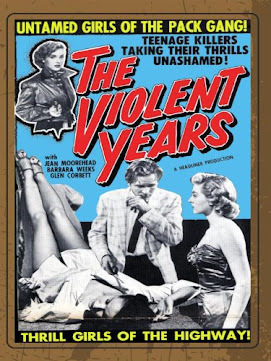 One of Ed Wood's crime thrillers.Synopsis: A young thug named Dirk brutally murders a young woman named Lisa at Lover's Lane. He's been instructed to do this by his boss, Janet, but Dirk views his killings as "art" and doesn't really care about any financial compensation. Janet is the leader of an underground smut ring, and Lisa was about to rat her out to the police and so had to be eliminated. Dirk has done his part, but Janet is furious that he left a pornographic picture at the crime scene.
One of Ed Wood's crime thrillers.Synopsis: A young thug named Dirk brutally murders a young woman named Lisa at Lover's Lane. He's been instructed to do this by his boss, Janet, but Dirk views his killings as "art" and doesn't really care about any financial compensation. Janet is the leader of an underground smut ring, and Lisa was about to rat her out to the police and so had to be eliminated. Dirk has done his part, but Janet is furious that he left a pornographic picture at the crime scene. Dirk's solution is to commit further murders and mayhem at Lover's Lane, making the cops think there's a sex-crazed psycho on the loose. They'll be so busy trying to catch him that they'll forget all about the smut ring. Dirk's insidious plan almost works, but one of his intended victims turns out to be an undercover cop in drag. Dirk barely escapes arrest, and Janet decides that he should lay low for a while. She has her boyfriend Danny drive Dirk to the home of Paula Parkins (aka Paul), a wealthy young lady who's part of a gang of female juvenile delinquents. Dirk, Paula, and the gang enjoy a wild and violent party, during which they watch some stag films starring the girls.
Later, Janet delivers some of the aforementioned stag films to a hard-boiled lady gangster named Gloria. It turns out Gloria is having some of the same problems that Janet had been having with Lisa earlier. She sure could use a hitman right about now, someone to neutralize any threats. Janet offers Dirk's services. Gloria thinks Dirk has potential.
Excerpt:
His body was black and blue with bruises, there were bite marks on his legs and shoulders. The gash on his chest had needed four stitches but it was barely a scratch. The trunk of the Star Chief was full of 8mm film cannisters, wrapped in flowered sheets stolen from Paula's parents' bed before they could come back and see the damage.
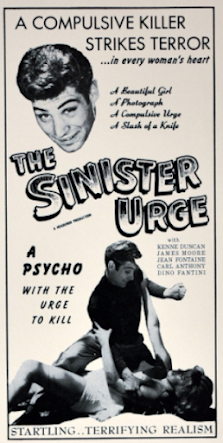 Dirk does his thing.Reflections: Some prayers are answered, readers. Not all, but some. At this point in my journey through Ed Wood's Warm Angora Wishes and Rubber Octopus Dreams, for instance, I was praying for a story that had nothing whatsoever to do with ghouls, flying saucers, aliens, haunted houses, or cemeteries. I'd had my fill of all those things. Then Brian Carney, like a true hero, came to my rescue with a story inspired by two of Ed Wood's crime dramas, The Violent Years (1956) and The Sinister Urge (1960). Eddie's sci-fi and horror films tend to hog the spotlight, so it's nice to see his noir efforts get some love for a change.
Dirk does his thing.Reflections: Some prayers are answered, readers. Not all, but some. At this point in my journey through Ed Wood's Warm Angora Wishes and Rubber Octopus Dreams, for instance, I was praying for a story that had nothing whatsoever to do with ghouls, flying saucers, aliens, haunted houses, or cemeteries. I'd had my fill of all those things. Then Brian Carney, like a true hero, came to my rescue with a story inspired by two of Ed Wood's crime dramas, The Violent Years (1956) and The Sinister Urge (1960). Eddie's sci-fi and horror films tend to hog the spotlight, so it's nice to see his noir efforts get some love for a change."The Violent Urge" manages to answer one of the nagging questions from Ed Wood's filmography. Namely, how did gangster Gloria Henderson (Jean Fontaine) ever wind up hiring a loose-cannon thug like Dirk Williams (Dino Fantini) in The Sinister Urge? You have to admit, it's a strange pairing. She's no-nonsense; he's basically all nonsense. She demands order; he offers chaos. She tries to keep a low profile; he's bound to attract attention. And, ultimately, Dirk proves a liability to Gloria's operation.
Author Brian Carney manages to craft a convincing origin story for the unlikely Gloria/Dirk alliance, and he incorporates the juvenile delinquents from The Violent Years. I was glad to spend a little more time with those fun-loving gals. Does Paula Parkins (Jean Moorhead) get to say her famous "so what?" catchphrase from the movie? You'd better believe she does. As a little flourish, Carney includes a sly reference to Hellborn (1956), one of Ed's unfinished films. Janet and Dirk are said to have attended Wellbourne High School, known colloquially as Hellborn High.
Better yet, Carney manages to write all of this in the gleefully nasty style of a trashy pulp novel, complete with loving descriptions of lurid violence. (The story literally starts with a lengthy, drawn-out description of a stabbing.) The author refers to the shared fictional world depicted in this story as the "Delinquiverse," which I love. It would have been nice to include mixed-up Don Gregor (Clancy Malone) from Jail Bait (1954), too. Don, like Paula Parkins, is a spoiled, bored rich kid who gets into crime for kicks, so they may have had a lot in common. But then, what would Carney have called the story? "The Violent Jail Urge"?
var infolinks_pid = 3415273; var infolinks_wsid = 0;
Published on August 28, 2024 03:00
August 25, 2024
Ed Wood's Warm Angora Wishes: "Plan 9.1 from Outer Space"
 Let's make just a slight adjustment to this famous title.
Let's make just a slight adjustment to this famous title.The story: "Plan 9.1 from Outer Space" by Robert Kokai
NOTE: This article continues my coverage of Ed Wood's Warm Angora Wishes and Rubber Octopus Dreams (Arcane Shadows Press, 2024).
Synopsis: The narrator reveals he is in possession of the journal of an evil alien named Belug, the ruler of a race of space vampires who wish to conquer as many planets as possible, including Earth. The journal spans millions of years and details Belug's numerous unsuccessful attempts to take over our world with the questionable assistance of the oafish Space Admiral Torbo and the sexy Yeoman Vampita.
The saga begins circa 67,000,000 B.C. (The author has helpfully converted all the space dates in Belug's journal into earth dates.) The aliens' first two plans fail quickly because of foolish mistakes on Torbo's part. Plan Three at least gets Belug and his crew to Mars, where Torbo successfully wrestles a bear. However, Torbo's numerous, disgusting gastrointestinal problems make the mission unpleasant for everyone on board the flying saucer. The aliens visit Earth but find no humans, only dinosaurs. These "thunder lizards" eat Torbo and Vampita, and Belug is forced to "rebirth" them using his own body.
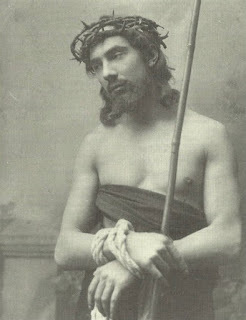 Bela Lugosi as Jesus.The vampires visit Earth a few million years later (this is Plan Four) and find some primitive homo sapiens there. Belug even meets a "hot little divorcee named Lilith" and begins an affair with her, but he quickly flees when he realizes she is "astonishingly fertile." Plan Five occurs in the year 48 B.C. Belug meets Julius Caesar and Cleopatra, but he accidentally sets fire to the Library at Alexandria. Plan Six happens in 30 A.D. but is abandoned when Belug meets Jesus, the actual son of God. Plans Seven and Eight allow the space vampires to witness the French Revolution and the American Civil War, respectively. Belug is both impressed and distressed by the brutality of the human race.
Bela Lugosi as Jesus.The vampires visit Earth a few million years later (this is Plan Four) and find some primitive homo sapiens there. Belug even meets a "hot little divorcee named Lilith" and begins an affair with her, but he quickly flees when he realizes she is "astonishingly fertile." Plan Five occurs in the year 48 B.C. Belug meets Julius Caesar and Cleopatra, but he accidentally sets fire to the Library at Alexandria. Plan Six happens in 30 A.D. but is abandoned when Belug meets Jesus, the actual son of God. Plans Seven and Eight allow the space vampires to witness the French Revolution and the American Civil War, respectively. Belug is both impressed and distressed by the brutality of the human race.The project takes a major shift with the ninth and final plan, which goes into action in 1900 A.D. Belug has Torbo and Vampita drop him off on Earth, where he passes himself off as human and becomes a stage actor in Hungary. The alien ruler remains on Earth for decades in this form. He portrays both Jesus Christ and Count Dracula and also serves in the first World War. He then moves to America, where he acts on Broadway and then in motion pictures. By the late 1940s, his career has seen some ups and downs, but Torbo and Vampita have it even worse. They've been captured and detained in a place called Roswell, New Mexico.
By the 1950s, Belug is down on his luck, but he meets and begins working with a young filmmaker named Eddie. The films aren't good, but they give Belug something to do. Circa 1956, something strange happens: Belug becomes invisible. He can still see and hear what's happening, but no one can see or hear him. He wanders the streets of Hollywood for years, touched that people still remember him from his movies.
Excerpt:
I went to the movies today. Son of a bitch! The movie I saw was The Day the Earth Stood Still. It was like watching my life story. Seriously, 67,000,000 years all crammed into an hour and a half. It's the story of this guy from outer space named Klaatu who comes to Earth and lives with the Earth people to study them. That's what I've been doing!
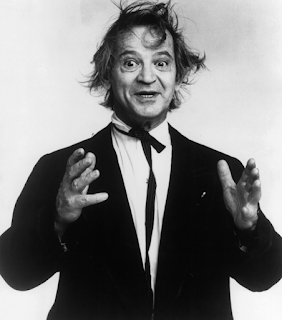 Foremost authority Prof. Irwin CoreyReflections: "Plan 9.1 from Outer Space" is one of the longer pieces in Warm Angora Wishes, and it's also one of the more difficult stories to review because of its sizable shifts in tone and style. It starts as one kind of story, morphs into another, and ends up as a third. I began to wonder if the author, Robert Kokai, had a game plan in advance when he sat down to write this or if he simply allowed his imagination to wander freely as he improvised this story.
Foremost authority Prof. Irwin CoreyReflections: "Plan 9.1 from Outer Space" is one of the longer pieces in Warm Angora Wishes, and it's also one of the more difficult stories to review because of its sizable shifts in tone and style. It starts as one kind of story, morphs into another, and ends up as a third. I began to wonder if the author, Robert Kokai, had a game plan in advance when he sat down to write this or if he simply allowed his imagination to wander freely as he improvised this story.In its early stages, "Plan 9.1" reminded me of the monologues of a comedian called Professor Irwin Corey (1914-2017). You might remember the disheveled, raspy-voiced Corey from his many TV and film appearances, especially on late-night talk shows. He looked like a combination of a country preacher and a mad scientist, and he was billed as "the world's foremost authority." Authority on what, exactly? Well, everything and nothing. He would proceed to give lectures about various topics as if he were some great expert on them, but his speeches/sermons would consist of a lot of silly puns and non sequiturs and wouldn't really convey any useful information.
Robert Kokai starts out in the Irwin Corey mode, pontificating at some length about the big bang and other topics without really communicating anything. Then, once the diary entries commence, the author uses the misadventures of the space vampires as the springboard for some middle-school-level sex jokes about Vampita and some elementary-school-level bodily function jokes about Torbo. But Kokai also uses the journal entries to comment on the follies of the human race, namely our penchant for killing each other with greater and greater efficiency over the centuries.
In its final stages, the story becomes a commentary on the life and career of Bela Lugosi, and it even gives us an origin story for how Bela met Ed Wood and came to be in several of Eddie's movies. Think of it as Ed Wood (1994) on a crash diet. These reflective, bittersweet passages—also reminiscent of David Bowie in The Man Who Fell to Earth (1976)—largely abandon the Corwin-esque silliness of the early part of the story and the schoolboy humor of the middle part of the story. That's why I said that "Plan 9.1 from Outer Space" is like three stories in one.
Though I've never met Mr. Kokai, a horror host in his own right, I can only imagine that a conversation with him would be entertaining, exhausting, and largely one-sided. An innocent question like "How are you?" might well provoke a half-hour answer.
Before we leave this story, I would like to point out that "Plan 9.1 from Outer Space" covers some of the same comedic ground as a song called "Plans One Thru Nine" by The Rifftones. I had a vague memory of hearing this song several years ago, but it was the redoubtable Philip R. Frey who helped me identify the title and artist. Thank you!
P.S. We are just ten stories into this anthology, and this is already the third named after Plan 9 from Outer Space (1957). We've previously had "Ridin' the Sunset Trail with the Plan 9 Kid" and "Plan One from Poughkeepsie." I get that Plan 9 is Ed Wood's defining work, but I'd kill for some Bride and the Beast (1955) fanfiction right about now.
var infolinks_pid = 3415273; var infolinks_wsid = 0;
Published on August 25, 2024 13:50
August 23, 2024
Ed Wood's Warm Angora Wishes: "The Black Madonna of Pioneer Cemetery"
 There's a very familiar-seeming ghoul at this cemetery.
There's a very familiar-seeming ghoul at this cemetery.The story: "The Black Madonna of Pioneer Cemetery" by Lina Martine
NOTE: This article continues my coverage of Ed Wood's Warm Angora Wishes and Rubber Octopus Dreams (Arcane Shadows Press, 2024).
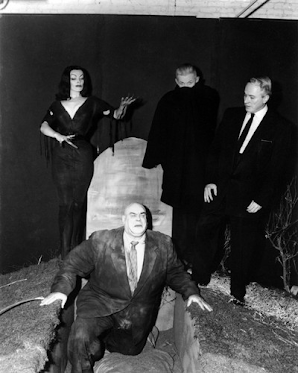 The spooktacular cast of Plan 9.Synopsis: After attending a horror movie, two young couples on a double date decide to visit a creepy and mostly-abandoned cemetery. One of the girls, Tina, is reluctant to explore the grounds, even though it was her idea to go there in the first place! Ultimately, she and the others—Jimmy, Betty (aka Betts), and Eddie—climb over the fence that surrounds the graveyard. The rather eccentric but nice Eddie is especially excited to visit the grave of an outlaw named Freno Frost and make a rubbing of his tombstone. Tina is dating Eddie only because he's friends with Jimmy. She plans to become Jimmy's girlfriend once he and the fickle Betty inevitably break up.
The spooktacular cast of Plan 9.Synopsis: After attending a horror movie, two young couples on a double date decide to visit a creepy and mostly-abandoned cemetery. One of the girls, Tina, is reluctant to explore the grounds, even though it was her idea to go there in the first place! Ultimately, she and the others—Jimmy, Betty (aka Betts), and Eddie—climb over the fence that surrounds the graveyard. The rather eccentric but nice Eddie is especially excited to visit the grave of an outlaw named Freno Frost and make a rubbing of his tombstone. Tina is dating Eddie only because he's friends with Jimmy. She plans to become Jimmy's girlfriend once he and the fickle Betty inevitably break up.The four young people are shocked when a tomb opens and a female ghoul emerges. They all immediately recognize her as the Witch, a sinister woman who'd been married to a much-older man. Jimmy, Tina, Betty, and Eddie are terrified when they hear more figures approaching them in the dark. The Witch attacks Jimmy and begins clawing and chewing him. Betty tries to fight her, but to no avail. Then, the Old Man attacks her by biting her neck.
The two survivors, Eddie and Tina, have no choice but to abandon their doomed friends and make a run for it. While trying to leave the cemetery, they barely escape a third ghoul: a large, clumsy, heavyset man. Betty and Jimmy are never heard from again, while Tina and Eddie break up due to the latter's transvestism.
Excerpt:
Tina's eyes were glued to the tomb door, which continued to swing outward. Spindly white arms reached out of the darkness inside. A lean, white, wolf-like face loomed out of the inky blackness, lips curled in a savage snarl. Shaking and quivering spasmodically, a woman in a torn black dress staggered out into the moonlight. She lurched to a halt, face turned up toward the moon, and let out a piercing shriek.Reflections: As I've made my way through Warm Angora Wishes and Rubber Octopus Dreams, I've been reminded that Ed Wood is still largely defined by the handful of films he made in the 1950s. You say Ed's name, and people think of ghouls, cemeteries, and angora sweaters. All of those things are on prominent display in "The Black Madonna of Pioneer Cemetery," a story that takes the three iconic zombies from Plan 9 from Outer Space (1957)—the ones played by Vampira, Bela Lugosi, and Tor Johnson—and gives them a new set of victims to chow down on.
But author Lina Martine obviously knows more about Ed Wood than just the few core movies that have been played to death. For example, she includes a prominent reference to Kenne Duncan's character Freno Frost from The Lawless Rider (1954), an extremely obscure Western co-written by Ed. Who else but a superfan would even know that? And the story's framing device, i.e. horny young people visiting a spooky old cemetery, feels like a nod to Orgy of the Dead (1965). Come to think of it, cemeteries remained prominent in Ed's writing all the way through his career, even during his porn days of the '60s and '70s. If he could steer a story toward a cemetery, he would.
In her biography at the end of the story, Martine declares herself "addicted to James Dean/Maila Nurmi gossip." It's no surprise that Maila's Plan 9 character is at the very center of this story and that one of the doomed youngsters is named Jimmy. The story even mentions Jimmy's movie-star good looks, and I'm sure it's symbolic that Maila's character literally tries to eat him alive. Eddie is obviously a stand-in for Ed Wood, right down to his angora sweater fetish. But are the characters Betty and Tina meant to represent anyone in particular, or are they just typical horror movie victims? Only the author knows for sure.
var infolinks_pid = 3415273; var infolinks_wsid = 0;
Published on August 23, 2024 18:48
August 21, 2024
Ed Wood's Warm Angora Wishes: "Plan One from Poughkeepsie"
 Bela Lugosi and the Hindenburg both had an impact on Ed Wood's childhood.
Bela Lugosi and the Hindenburg both had an impact on Ed Wood's childhood.The story: "Plan One from Poughkeepsie" by Frank Dello Stritto
NOTE: This article continues my coverage of Ed Wood's Warm Angora Wishes and Rubber Octopus Dreams (Arcane Shadows Press, 2024).
Synopsis: December 1936, Poughkeepsie, New York. Edward D. Wood, Jr., 12 years of age, skips school to attend a showing of The Invisible Ray starring Boris Karloff and Bela Lugosi. The truant officer catches him and reports him to his parents. Apparently, Eddie does this kind of thing frequently, much to his father's chagrin. Nevertheless, on Christmas Day, Eddie's parents give him his own 8mm movie camera, a Kodak Cine Special. Junior stores this treasured gift in the same closet where he keeps the dress that his mother gave him.
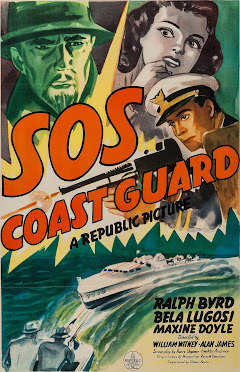 A Bela Lugosi serial.During that same Christmas break, Eddie sees the final chapter of a Bela Lugosi serial called Shadow of Chinatown (1936). The ending is a dud, but this is how the budding filmmaker learns about stock footage. He dreams of making a combination horror film and Western starring his idol, Buck Jones. Has anyone done that before, he wonders?
A Bela Lugosi serial.During that same Christmas break, Eddie sees the final chapter of a Bela Lugosi serial called Shadow of Chinatown (1936). The ending is a dud, but this is how the budding filmmaker learns about stock footage. He dreams of making a combination horror film and Western starring his idol, Buck Jones. Has anyone done that before, he wonders?May 1937. Junior has been struggling to learn how to use his new camera, and some of his precious, expensive footage has been overexposed. But he does manage to film the Hindenburg as it flies overhead. Later, over the radio, he hears that the famed German airship has burst into flames. He makes sure to take good care of the film he shot.
December 1937. Eddie, now 13, watches another Lugosi serial called SOS Coast Guard at the local movie theater with his friends. The only part he likes is how Lugosi's villainous character is killed alongside his giant sidekick, Thorg. He also sees a newsreel about the Hindenburg and remembers the footage he has stashed away in his closet. He shows the film at school, where it makes a big hit with his classmates. This is the moment when he decides he wants to be a filmmaker when he grows up. Again, he carefully stashes the film in the closet at home alongside his favorite dress.
December 1939. Two years have passed, and Eddie is still watching Bela Lugosi serials. This time, it's The Phantom Creeps, with Bela as a mad scientist with a killer robot. Eddie is shocked and thrilled when the film uses a clip of the Hindenburg flying over what might be Poughkeepsie. Eddie is again impressed by the clever use of stock footage and vows to make his own movies someday.
Excerpt:
Reflections: It had never occurred to me to compare Ed Wood to Jean Shepherd, but "Plan One from Poughkeepsie" reads like an alternate universe version of A Christmas Story (1983). Imagine Ed Wood as Ralphie, pining for a Kodak Cine Special instead of a Red Ryder BB gun, with cantankerous but lovable Ed Wood, Sr. as the Old Man, Lillian Wood as Mrs. Parker, and Eddie's little brother Bill as Randy Parker.
Junior and his friends sat in the theatre. He told them about an Amazing Story that he had just read. A mad doctor was trying to create a race of supermen. Then the boys ran through the plot of the serial whose first 11 chapters they had seen. The last chapter would start in a few moments. The houselights dimmed.
In this short story, much of which takes place at Christmas, young Eddie is inspired by the same things that inspire Ralphie: comic books, radio shows, and cowboy films. Since Ed Wood and Jean Shepherd were born just a few years apart (1924 and 1921, respectively), it stands to reason they had similar experiences growing up in America. I'd imagine, however, that if young Eddie got a fuzzy pink bunny suit for Christmas, he would secretly love it.
"Plan One from Poughkeepsie" is Frank Dello Stritto's imagining of what Ed Wood's childhood in 1930s Poughkeepsie was like. As the author admits in the story's prologue, he's really piecing this narrative together from the few scraps of information we have about Ed's adolescence. And since Eddie had such a tenuous relationship with reality, who knows how much of this actually happened? All we can do is guess. It's to Dello Stritto's credit that "Plan One" is plausible. It may or may not be accurate, but it seems like it could be. It has the ring of truth to it.
var infolinks_pid = 3415273; var infolinks_wsid = 0;
Published on August 21, 2024 03:00



